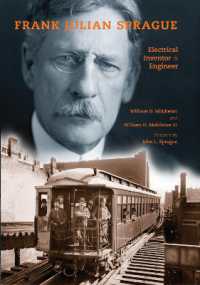- ホーム
- > 洋書
- > 英文書
- > History / World
Full Description
Scholars, journalists, and policymakers have long argued that the 1965 Immigration and Nationality Act dramatically reshaped the demographic composition of the United States. In A Nation of Immigrants Reconsidered, leading scholars of immigration explore how the political and ideological struggles of the "age of restriction"--from 1924 to 1965--paved the way for the changes to come. The essays examine how geopolitics, civil rights, perceptions of America's role as a humanitarian sanctuary, and economic priorities led government officials to facilitate the entrance of specific immigrant groups, thereby establishing the legal precedents for future policies. Eye-opening articles discuss Japanese war brides and changing views of miscegenation, the recruitment of former Nazi scientists, a temporary workers program with Japanese immigrants, the emotional separation of Mexican immigrant families, Puerto Rican youth's efforts to claim an American identity, and the restaurant raids of conscripted Chinese sailors during World War II. Contributors: Eiichiro Azuma, David Cook-Martín, David FitzGerald, Monique Laney, Heather Lee, Kathleen López, Laura Madokoro, Ronald L. Mize, Arissa H. Oh, Ana Elizabeth Rosas, Lorrin Thomas, Ruth Ellen Wasem, and Elliott Young
Contents
CoverTitleCopyrightContentsAcknowledgmentsIntroductionPart I. Policy and LawBeyond Borders: Remote Control and the Continuing Legacy of Racism in Immigration LegislationGatekeeping in the Tropics: US Immigration Policy and the Cuban ConnectionContested Terrain: Debating Refugee Admissions in the Cold WarThe Geopolitical Origins of the 1965 Immigration ActPart II. LaborHunting for Sailors: Restaurant Raids and Conscription of Laborers during World War IIThe State Management of Guest Workers: The Decline of the Bracero Program, the Rise of Temporary Worker VisasSetting the Stage to Bring in the "Highly Skilled": Project Paperclip and the Recruitment of German Specialists after World War IIJapanese Agricultural Labor Program: Temporary Worker Immigration, US-Japan Cultural Diplomacy, and Ethnic Community Making among Japanese AmericansPart III: "Who is a Citizen? Who Belongs?"The Undertow of Reforming ImmigrationForeign, Dark, Young, Citizen Puerto Rican Youth and the Forging of an American Identity, 1930-70Japanese War Brides and the Normalization of Family Unification after World War IILove as Mirror and Pathway: The Undocumented Emotive Configuration of Mexican ImmigrationAfterword: The Black Presence in US Immigration HistoryContributorsIndex







